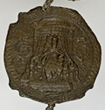A self-governing community
 |
Statutes of the university, fifteenth - eighteenth centuries (UA Junior Proctor’s Book, Collect.Admin.2, ff. 56v-57r) |
Migrating to Cambridge from Oxford in 1209 following local disturbances, the senior scholars, known as masters, and their student apprentices quickly evolved an institutional framework. Within 40 years, this was written down as statutes: putting a chancellor at its head, naming other officers, and prescribing a masters’ court, judicial procedures, academical dress and discipline.
Although the relative authority of senior and junior members and independence from ecclesiastical and royal influence have varied over time, the university continues to embody its structure and organisation in statutes. Assemblies of masters, determining everything from requirements for a degree to disposal of property, have taken several guises. From at least 1526, executive power lay with the small Caput Senatus, dominated by the vice-chancellor and senior academics. Victorian reformers replaced it with a more broadly representative, elected Council, forerunner of the current body, now including students and external members. Ultimate authority rests with the Regent House - those holding official positions in the university and colleges - who discuss and ratify Council proposals, occasionally by vote.
Click to view larger images:


